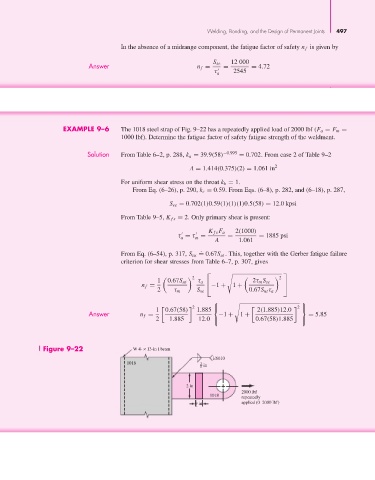Page 523 - Shigley's Mechanical Engineering Design
P. 523
bud29281_ch09_475-516.qxd 12/16/2009 7:13 pm Page 497 pinnacle 203:MHDQ196:bud29281:0073529281:bud29281_pagefiles:
Welding, Bonding, and the Design of Permanent Joints 497
In the absence of a midrange component, the fatigue factor of safety n f is given by
12 000
S se
Answer n f = = = 4.72
τ a 2545
EXAMPLE 9–6 The 1018 steel strap of Fig. 9–22 has a repeatedly applied load of 2000 lbf (F a = F m =
1000 lbf). Determine the fatigue factor of safety fatigue strength of the weldment.
Solution From Table 6–2, p. 288, k a = 39.9(58) −0.995 = 0.702. From case 2 of Table 9–2
A = 1.414(0.375)(2) = 1.061 in 2
For uniform shear stress on the throat k b = 1.
From Eq. (6–26), p. 290, k c = 0.59. From Eqs. (6–8), p. 282, and (6–18), p. 287,
S se = 0.702(1)0.59(1)(1)(1)0.5(58) = 12.0 kpsi
From Table 9–5, K fs = 2. Only primary shear is present:
K fs F a 2(1000)
= 1885 psi
τ = τ = =
m
a
A 1.061
.
From Eq. (6–54), p. 317, S su = 0.67S ut . This, together with the Gerber fatigue failure
criterion for shear stresses from Table 6–7, p. 307, gives
⎡ ⎤
1 0.67S ut
2 τ a 2τ m S se
2
n f = ⎣ −1 + 1 + ⎦
2 τ m S se 0.67S ut τ a
⎧ ⎫
2
1 0.67(58) 1.885 ⎨ 2(1.885)12.0 2 ⎬
Answer n f = −1 + 1 + = 5.85
2 1.885 12.0 ⎩ 0.67(58)1.885 ⎭
Figure 9–22 W 4- × 13-in I beam
E6010
1018 3 in
8
2 in
2000 lbf
1018 repeatedly
1 in applied (0–2000 lbf)
2

